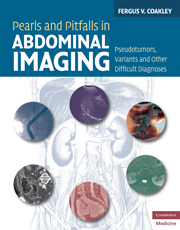Book contents
- Frontmatter
- Contents
- Preface
- Acknowledgements
- Section 1 Diaphragm and adjacent structures
- Section 2 Liver
- Section 3 Biliary system
- Case 22 Peribiliary cysts
- Case 23 Pseudo-Klatskin tumor due to malignant masquerade
- Case 24 Adenomyomatosis of the gallbladder
- Case 25 Pseudotumor of the distal common bile duct
- Case 26 Pancreaticobiliary maljunction
- Section 4 Spleen
- Section 5 Pancreas
- Section 6 Adrenal glands
- Section 7 Kidneys
- Section 8 Retroperitoneum
- Section 9 Gastrointestinal tract
- Section 10 Peritoneal cavity
- Section 11 Ovaries
- Section 12 Uterus and vagina
- Section 13 Bladder
- Section 14 Pelvic soft tissues
- Section 15 Groin
- Section 16 Bone
- Index
- References
Case 23 - Pseudo-Klatskin tumor due to malignant masquerade
from Section 3 - Biliary system
Published online by Cambridge University Press: 05 November 2011
- Frontmatter
- Contents
- Preface
- Acknowledgements
- Section 1 Diaphragm and adjacent structures
- Section 2 Liver
- Section 3 Biliary system
- Case 22 Peribiliary cysts
- Case 23 Pseudo-Klatskin tumor due to malignant masquerade
- Case 24 Adenomyomatosis of the gallbladder
- Case 25 Pseudotumor of the distal common bile duct
- Case 26 Pancreaticobiliary maljunction
- Section 4 Spleen
- Section 5 Pancreas
- Section 6 Adrenal glands
- Section 7 Kidneys
- Section 8 Retroperitoneum
- Section 9 Gastrointestinal tract
- Section 10 Peritoneal cavity
- Section 11 Ovaries
- Section 12 Uterus and vagina
- Section 13 Bladder
- Section 14 Pelvic soft tissues
- Section 15 Groin
- Section 16 Bone
- Index
- References
Summary
Imaging description
The term malignant masquerade [1] refers to benign idiopathic fibroinflammatory stricturing of the common hepatic duct confluence that is clinically and radiologically (Figure 23.1) indistinguishable from hilar cholangiocarcinoma (Klatskin tumor).
Importance
While, virtually by definition, malignant masquerade cannot be diagnosed by imaging alone, recognition of this pseudotumor emphasizes the importance of offering surgery to all patients with what appears to be a resectable hilar cholangiocarcinoma. Palliative treatment of these patients, particularly with metallic endobiliary stenting, is rarely appropriate without a histological diagnosis because the assumption of malignancy may be incorrect and because such treatment may complicate or preclude subsequent surgery.
Typical clinical scenario
Studies have consistently shown that 5 to 10% of patients with a presumptive preoperative diagnosis of hilar cholangiocarcinoma are ultimately found to have an idiopathic benign stricture at final histopathological review [2].
Differential diagnosis
Benign idiopathic fibroinflammatory strictures of the common hepatic duct confluence appear to represent several different histopathological entities, including lymphoplasmacytic sclerosing pancreatitis and cholangitis, primary sclerosing cholangitis, granulomatous disease, non-specific fibrosis and inflammation, and occult stone disease [2].Lymphoplasmacytic sclerosing pancreatitis and cholangitis is a distinct and relatively recently recognized autoimmune disorder [3] which may primarily manifest in the pancreas (where it is also known as lymphoplasmacytic sclerosing pancreatitis or autoimmune pancreatitis) but can also primarily affect the biliary system [4].
Information
- Type
- Chapter
- Information
- Pearls and Pitfalls in Abdominal ImagingPseudotumors, Variants and Other Difficult Diagnoses, pp. 76 - 79Publisher: Cambridge University PressPrint publication year: 2010
